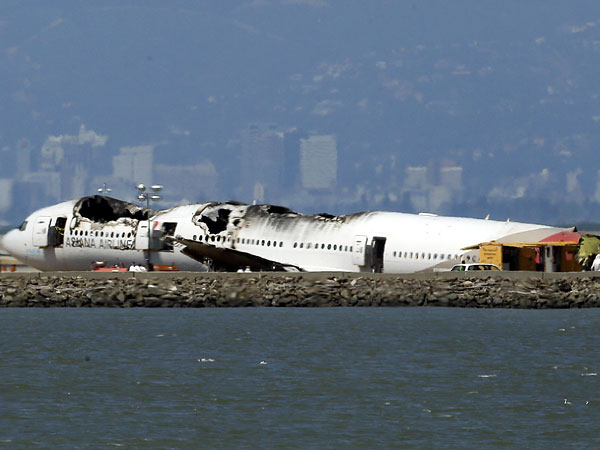
BLIND SIDE The wreckage of Asiana Airlines Flight 214 that crashed upon landing Saturday at San Francisco International Airport sits on the tarmac Monday, July 8, 2013 in San Francisco. Investigators said Tuesday the pilot of the Boeing 777 couldn’t see the runway seconds before the crash, given how far the plane was out of position. Two of the 307 passengers aboard were killed. AP FILE PHOTO
SAN FRANCISCO — The flight crew of the Asiana Airlines Boeing 777 which crash landed at San Francisco Airport couldn’t see the runway just seconds earlier, given how far the plane was out of position, US investigators said Tuesday.
With attention focused on whether human error caused the aircraft to slam into the ground, missing the runway, it was also confirmed that the training pilot on board was undertaking his inaugural flight as an instructor.
The crash killed two Chinese students and left more than 180 injured, but given the heavy impact and extent of the damage experts have said it was fortunate that the death toll was not higher.
Three of Asiana Flight 214’s four pilots have now been interviewed, said National Transportation Safety Board chair Deborah Hersman, who is leading the probe, and who described their last ditch attempt to avert disaster.
“The pilot that was sitting in the jump seat, the relief first officer, identified that he could not see the runway… from his seated position. And that the aircraft — the nose was pitched up, so he couldn’t see the runway,” Hersman said.
And the accident happened just seconds later, when at an altitude of only 500 feet the instructor pilot “realized they were too low.”
“He went to push the throttles forward, but he stated that the pilot had already — the other pilot had already pushed the throttles forward,” said Hersman, outlining how the crash unfolded.
Investigators previously stated that just 1.5 seconds before the plane smashed into the ground, a member of the flight crew asked to abort the landing, though it was too late to take such action.
The aircraft clipped a seawall and went skidding out of control, breaking up and quickly bursting into flames when one of its engines caught fire.
The fourth pilot — the relief Captain — was in the cabin and not in the cockpit at the time of the crash.
The pilot at the controls — named by Asiana as Lee Kang-Kuk — was around halfway through his training for the Boeing 777, but had led 29 flights to San Francisco on Boeing 747s in the past, according to the airline.
“To complete initial operating experience for Asiana, he’s required to have 20 flights and 60 flight hours. He had 10 legs — he had completed 10 legs. And about 35 hours flying the 777,” Hersman said Tuesday.
However, his trainer — who told US investigators he had a total of 13,000 flying hours, 3,000 of which were in the Boeing 777 — had not flown in that role before.
“He reported that this was his first trip as an instructor pilot,” Hersman said.
“The instructor pilot stated that he was the pilot in command. This was the first time that he and the flying pilot that he was instructing had flown together,” she added.
San Francisco General Hospital said Tuesday that five crash victims remain in critical condition.
The NTSB has said the plane was flying far too slowly before the disastrous landing, which shredded the aircraft’s tail, with the fire eventually leaving the fuselage a burned-out wreck.
South Korean-based Asiana earlier Tuesday defended the pilots as “very competent,” and the airline’s chief executive, Yoon Young-Doo, is to fly to California to meet transport safety officials and victims in local hospitals.
On Monday, Yoon lashed out at reports that pilot inexperience may have been to blame for the fatal crash, saying the speculation was “intolerable.”
Hersman has said the accident investigation will likely last until the weekend, and Tuesday reiterated that it is too early to draw conclusions.
“I want to say we’re at the beginning of the investigation. We’re gathering information,” she said.
In the eastern Chinese province of Zhejiang friends and family are mourning the two dead passengers — identified by state media as high-school classmates Ye Mengyuan, 16, and Wang Linjia, 17.
One of the girls may have been run over by an airport fire engine rushing to the scene, San Francisco Fire chief Joanne Hayes-White told reporters on Monday.
According to aviation safety databases, the two dead teens are the Boeing 777’s first fatalities in 18 years of service.